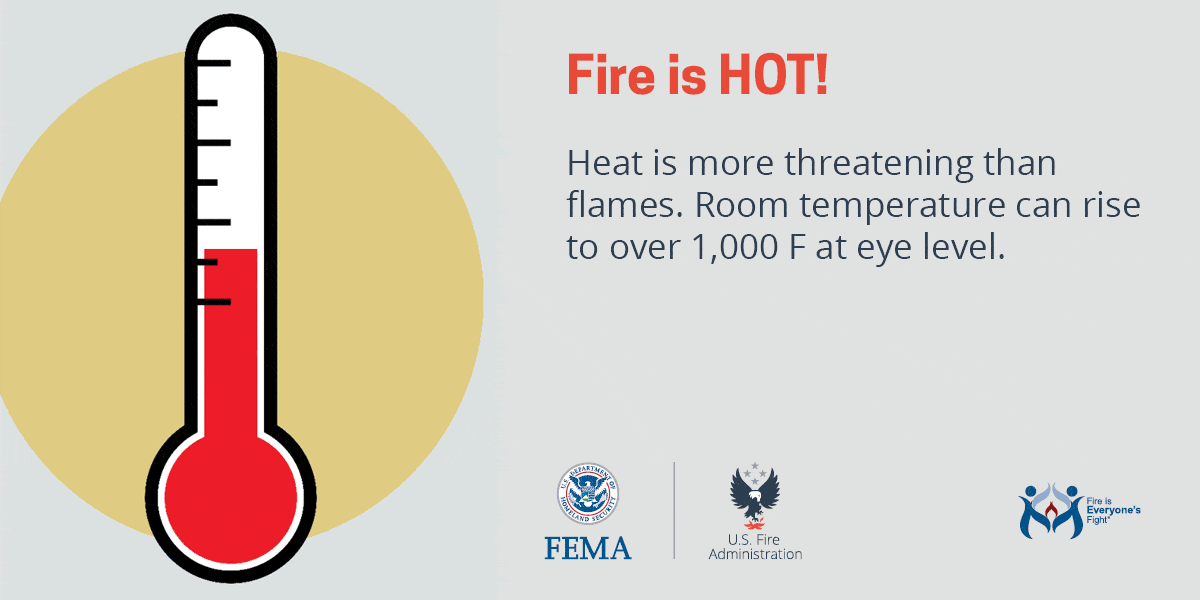“Fire won’t wait. Plan your escape™” is the 2022 campaign for NFPA's Fire Prevention Week, October 9-15. The goal is to educate the public on how they can keep safe from home fires. Every year, U.S. fire departments respond to an average of 346,800 home structure fires. These home fires cost about seven people their lives every day. And it's no wonder - a fire can engulf an entire home in under 5 minutes, becoming deadly in 2 minutes. So it's important to be prepared to respond quickly in an emergency. But we've made it easy for you to prepare! Follow our step-by-step instructions below on how to make an effective fire escape plan.
Here are a few important facts to learn about fire before you begin making your plan.
Fire is FAST!
Did you know that a fire can spread throughout an entire house in just 5 minutes? Because you have little time to get to safety, it’s important for your entire family to be prepared for this emergency.

Fire is DARK!
When you're planning your escape routes, keep in mind that it's difficult to see during a fire. While fires may start out bright, they quickly produce a lot of smoke, submerging occupants in complete darkness.

Fire is HOT!
Room temperatures can quickly exceed 1,000°F during a house fire. Be especially careful when touching walls, doors, and handles.

Map Your Home to Build Your Plan
To start making an effective fire escape plan, map out your home. Use grid paper or download the free escape plan grid below. On the grid paper, sketch the outline of your home. Next, add each room and hallway. Finally, locate every door and window on the map.
Your plan doesn't have to look pretty or use exact room measurements. But it should visually communicate escape routes from every area of your home.
Identify Best Exits for Escape
Walk through every room of your home and identify the best exits for escape. Try to find at least two exits out of each room, including doors and windows. Check the exits to make sure everyone can easily open them. Then, clear any objects blocking the exits, such as furniture.
For upper floors, designate a storage location of at least one collapsible ladder. Make sure everyone in your home knows where it is and can access it quickly.
Next, clearly mark each exit on your fire escape plan map. Also note the location of collapsible ladders.
Designate a Meeting Place After Escaping
Designate a meeting place after escaping that is outside and away from your house. Pick a spot that is easily identifiable at night, such as a streetlight or a trusted neighbor's mailbox. Then, draw a picture of the meeting place on your fire escape plan map.
List Action Steps of Your Fire Escape Plan
Now that you've mapped your escape plan, list all the actions family members will need to know during their evacuation. On your map, jot down bullet points of important actions to remember. Here are a few suggestions on action steps to consider.
Helping Others Escape
Children, seniors, and those with disabilities may need help to escape. Determine who in your household may need assistance waking up and/or getting to safety. Then, designate capable adults and/or older children to help those in need.
Get Out
Make sure everyone in your home knows how important it is to get out as quickly as possible once they hear a smoke alarm sound. Find the nearest safe route outside and get moving!
Close Doors As You Go
If you're the last one out of a room, close the door behind you. Closed doors may help slow the spread of smoke and heat, giving your family more time to escape.
Get Low
Most house fire deaths are the result of smoke inhalation (smoke poisoning). So, if smoke is filling your escape route, get low to move under the smoke. Duck, crouch, or crawl to move through smoke as quickly as possible.
Move to Designated Meeting Place
Once outside, move away from the house to your designated meeting place. Never go back inside for possessions, pets, or even people.
Call 9-1-1
Call 9-1-1 once you reach your meeting spot. If you weren't able to grab your phone, ask a neighbor to call for help.
How to Practice Your Fire Escape Plan
Once you've created your family's fire escape plan, write it down or draw a simple map. Store the plan somewhere easily accessible to all. Then, take time to explain the plan to every member of your household.
Set aside time to practice the plan together at least twice a year. Plan to practice once during the day and once while it's dark. Aim to complete your drills in under two minutes. Remember, the objective of a fire escape plan is to make sure that everyone feels confident they know how to respond to an emergency, not to instill fear.

